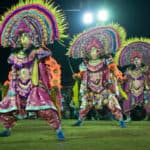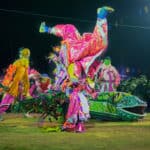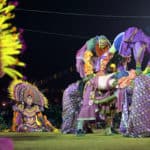Chhau or Chau is a semi classical Indian dance form originating from east India. This “tribal folk dance” is said to have developed from states such as Odisha, West Bengal, and Jharkhand. This form of dancing is further divided into three styles, which originate from three states i.e. the Mayurbhanj Chhau belonging to Odisha, the Purulia Chhau belonging to West Bengal, and Seraikella Chhau belonging to Jharkhand. In addition, this dance form has been created basically to enact stories related to the Hindu epics such as the Ramayana and Mahabharata. Furthermore, this dance has been developed by fusing elements of classical Indian dance styles with the tribal dance styles.
a. History/origin of Chhau Dance:
This dance form was basically created using elements of martial arts and tribal folk dances in the eastern coast of India. This dance is then further divided into three styles. They are as follows:
1. Mayurbhanj Chhau:
Developed in the state of Odisha in the Mayurbhanj district, this style does not involve the use of a mask by the performer.
2. Purulia Chhau:
Developed in the state of West Bengal, this style involves the use of a mask.
3. Seraikella Chhau:
Developed in the state of Jharkhand in the district of Seraikella and Kharsawan, this style also involves the use of the mask.
In addition, this dance form is said to have been developed by tribes belonging to the east India as tribute to the “Sun God” i.e. Lord Surya.
b. Costumes used in the Chhau dance:
The costumes used by the performer (mainly male) to cover the lower part of the body include dark green/yellow pyjamas for those playing the part of a god while, a black pyjama is used by those playing the role of a demon. In addition, costume which is extremely colourful is usually worn by the performer to cover up the upper body. Furthermore, masks are also used depending on the style performed. So for example, while the Purulia and the Seraikella style of Chhau dance requires the use of a mask, the Mayurbhanj style does not require the use of mask.
c. Music involved in the Chhau dance:
“Traditional folk songs” of the east India is what is mainly used as a part of music in this dance style. The instruments involved include various types of drums such as the Mahuri, dhol, and the dhamsa. In addition, the folk song accompanying this dance style is sung by a singer, who begins by invoking the presence of the almighty.
d. Training availability and the technique involved in the Chhau dance:
This dance form essentially combines the use of vigorous body movements along with the movement of the mask worn by the performer. It is via the movement of the mask that the performer manages to express human emotions such as joy, depression, anger etc. In addition, this dance style also involves a movement in which the performer “jumps in the air” which essentially is used to represent a war scene. Furthermore, since this dance form has basically originated from three states (i.e. Odisha, West Bengal and Jharkhand) indigenously and, has been passed on from one generation to another there are no training centres or schools available throughout the country.




